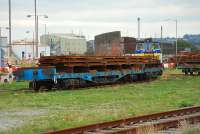Cleator and Workington Junction Railway
Introduction
This railway and its branches are closed. It arose due to high tolls on existing railways and was to serve the needs of the local iron masters. The line connected to all the Workington and Harrington area iron works and served various iron and coal pits, particularly the iron ore mines at Cleator, with connections to most of the other lines encountered. Generally it ran parallel to the existing coast line railway but above it. The last use was from Moss Bay Steel Works to Harrington Colliery No 10 via the Moss Bay branch, Harrington Church Road Halt and then on via Lowca. A further connection to this came from the former Gilgarron Branch from Parton by reversal. This closed in 1973 with the closure of the mine.
Dates
| / /1879 | Cleator and Workington Junction Railway Opened from Cleator to Distington, Derwent Iron Works and Workington. |
| / /1882 | Cleator and Workington Junction Railway Opened from Distington to Kelton Fell. |
| / /1885 | Cleator and Workington Junction Railway Opened from Harrington to Moss Bay. |
| / /1887 | Cleator and Workington Junction Railway Opened from Workington to Linefoot on the Maryport and Carlisle Railway. |
| / /1935 | Cleator and Workington Junction Railway Brigham Branch (Maryport and Carlisle Railway) closed. |
| / /1992 | Cleator and Workington Junction Railway Siddick Junction to Broughton via Calva Junction closed. |
Portions of line and locations
This line is divided into a number of portions.
Siddick to Cleator
This mainline of the railway was double track.
This station on the Whitehaven Junction Railway was the junction for the Cleator and Workington Junction Railway. It was a three platform station, two on the Whitehaven, served by both main line and branch, and a third on the east side only served from the branch making this an exchange station.
...
See also
Whitehaven Junction Railway

John McIntyre 30/08/2010
This colliery as just south of Siddick Junction between the Whitehaven Junction Railway and the Cleator and Workington Railway. It was served by sidings from the north. A colliery producing domestic and coking coal.
...
This was a double track junction north of Workington Central station. It was the west end of a curve which connected to the Cockermouth and Workington Railway just east of Workington Bridge station. The curve crossed the River Derwent.
...
This was a two platform station with a goods yard to the south on the east side of the line approached from the south. The main station building was on the southbound platform.
...

Mark Bartlett 09/03/2018
Lonsdale Dock Branch

Ewan Crawford 27/09/2006

Ewan Crawford /02/2010

Ewan Crawford 27/09/2006

Ewan Crawford 01/02/2010
Northern Extension

Ewan Crawford 27/09/2006

Ewan Crawford 27/09/2006

Ewan Crawford 27/09/2006
Workington Bridge Branch
This was a double track curve connecting to the Cockermouth and Workington Railway and crossing the River Derwent.
This was a double track junction north of Workington Central station. It was the west end of a curve which connected to the Cockermouth and Workington Railway just east of Workington Bridge station. The curve crossed the River Derwent.
...
This was the east end of a curve from the Cleator and Workington Railway where it met the existing Cockermouth and Workington Railway.
...
See also
Cockermouth and Workington Railway
Derwent Branch
Former iron works south of Workington on the west side of the Whitehaven Junction Railway, north of the Moss Bay Steel Works and Solway Colliery.
...
Mossbay Branch
Harrington Branch
This was a minimal single platform station on the north or west side of the line. It opened on the Cleator and Workington Junction Railway's Harrington Branch (later known as the Rosehill Branch) which connected Bain's Tramway to the Cleator and Workington Junction Railway.
...

Mark Bartlett 09/03/2018

Mark Bartlett 09/03/2018
This was a minimal single platform station on the west side of the line. It opened on the Cleator and Workington Junction Railway's Harrington Branch (later known as the Rosehill Branch) which connected Bain's Tramway to the Cleator and Workington Junction Railway. Rosehill Junction was just to the south and the station was built on the site of a former sand siding.
...
This was the junction between Bain's Tramway (later known as the Harrington and Lowca Light Railway) and the Cleator and Workington Junction Railway's Harrington Branch (later known as the Rosehill Branch).
...
See also
Harrington and Lowca Light Railway
Rowrah Branch







